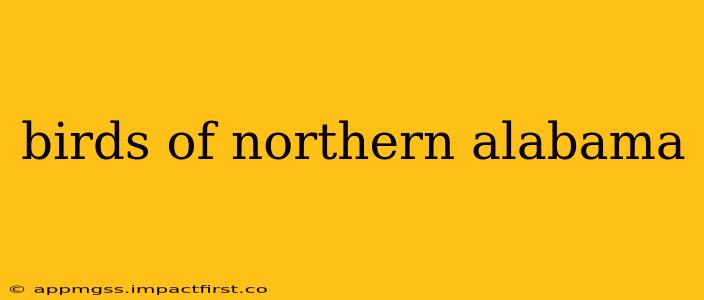Northern Alabama boasts a rich and diverse avian population, attracting birdwatchers from across the country. From the majestic bald eagle soaring overhead to the vibrant warblers flitting through the forests, the region offers a captivating spectacle for both seasoned ornithologists and casual observers. This guide delves into the fascinating world of birds found in Northern Alabama, exploring various species, habitats, and optimal times for birdwatching.
What are some common birds found in Northern Alabama?
Northern Alabama's diverse habitats, including forests, wetlands, and grasslands, support a wide array of bird species. Some of the most common include:
- Northern Cardinal: This vibrant red bird is a year-round resident, easily recognizable by its crest and melodious song.
- Blue Jay: Known for its intelligence and boisterous calls, the blue jay is a common sight in wooded areas.
- Downy Woodpecker: This small woodpecker is a frequent visitor to backyard feeders, pecking away at suet and nuts.
- American Robin: A beloved spring harbinger, the American robin is easily identified by its reddish-orange breast.
- Tufted Titmouse: This small, grayish bird with a prominent crest is a common sight in forests and woodlands.
- Carolina Wren: Known for its loud, bubbling song, the Carolina wren is a common resident of gardens and wooded areas.
- Mourning Dove: A peaceful and ubiquitous presence, mourning doves are easily identified by their soft cooing sound.
- Red-bellied Woodpecker: Despite its name, this woodpecker's belly is more of a reddish-orange. It's often found in mixed woodlands and urban areas.
What is the best time of year to birdwatch in Northern Alabama?
While birdwatching is enjoyable year-round, the best time to observe the greatest diversity of species is during the spring and fall migrations. These periods see a surge in the number of migratory birds passing through the region, adding to the resident population. Spring (March-May) brings vibrant warblers, tanagers, and vireos, while fall (September-November) offers a different set of migrants. Winter offers opportunities to see hardy species, and summer reveals the vibrant breeding plumage of many resident birds.
Where are the best places to birdwatch in Northern Alabama?
Northern Alabama offers a plethora of excellent birdwatching locations. Some of the best include:
- Land Between the Lakes National Recreation Area: This vast area encompasses diverse habitats, providing excellent opportunities to spot a wide variety of birds.
- Wheeler National Wildlife Refuge: This refuge protects crucial wetland habitats, supporting numerous waterfowl and shorebirds.
- Monte Sano State Park: This park's diverse terrain provides habitat for numerous bird species, with trails offering varied vantage points.
- Bankhead National Forest: This expansive forest offers opportunities for encountering a variety of woodland birds.
- Local Parks and Green Spaces: Many smaller parks and green spaces within cities and towns offer excellent opportunities for casual birdwatching.
What kind of birds migrate through Northern Alabama?
Numerous migratory birds utilize Northern Alabama as a stopover point during their annual journeys. Species vary depending on the season, but you can commonly see:
- Warblers: Many species of warblers pass through during spring and fall migrations, their bright colors adding a splash of vibrancy to the forests.
- Tanagers: These colorful birds are a highlight of the spring migration, with scarlet tanagers being a particularly striking species.
- Flycatchers: Various flycatcher species can be observed, using their aerial hunting skills to capture insects.
- Vireos: These small, often subtly colored birds are common migrants, often found in the treetops.
- Waterfowl: Ducks, geese, and other waterfowl utilize wetlands during migration, offering spectacular sights.
What birds are only found in Northern Alabama?
While no bird species is exclusively found in Northern Alabama, certain species have a higher concentration in this region compared to other parts of the state or country. Focusing on specific habitats within Northern Alabama will yield better chances of seeing certain species more frequently. For example, the presence of specific types of forests will attract certain woodpeckers or warblers, while wetland areas are hotspots for waterfowl. Detailed local birding guides and online resources are valuable for more precise information on localized species concentrations.
What equipment do I need for birdwatching in Northern Alabama?
Essential equipment for birdwatching includes:
- Binoculars: A good pair of binoculars is essential for observing birds at a distance.
- Field Guide: A field guide to birds of the region will help you identify the species you observe.
- Notebook and Pen: Record your sightings, noting the species, location, date, and any other relevant details.
- Camera (Optional): Capture photos of the birds you encounter to document your observations.
- Appropriate Clothing: Comfortable and weather-appropriate clothing is crucial, especially for longer outings.
By utilizing this guide and engaging in responsible birdwatching practices, you can embark on a rewarding journey of discovery into the captivating avian world of Northern Alabama. Remember to respect wildlife and their habitats, leaving no trace behind and observing birds from a safe distance. Happy birding!
